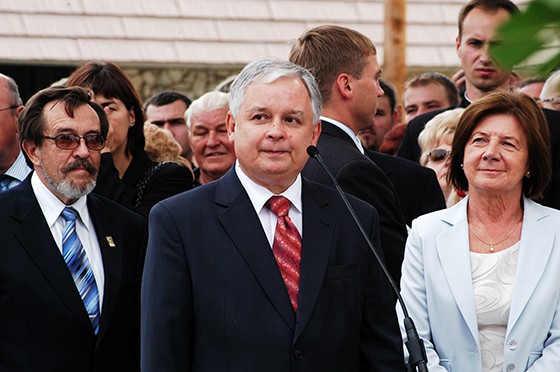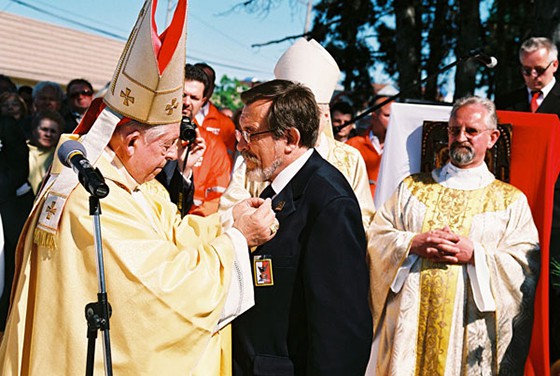
– My father was the greatest father in the world. He came to America in the fall of 1976 when I was 9 years old. Despite the fact that letters took weeks to arrive, we were in constant contact. I would get cards from him for every occasion. I collected them and kept them as relics. My sister and I always hoped that he’d surprise us one day with a visit. He cared for us a great deal. He worked two jobs, and for whatever he earned at one of them, he would buy things and send them to us in packages. He even sent packages to our distant family, and even to our poor neighbors. He would begin every day by answering the telephone — there was always someone who needed his help.
The late Wojciech Seweryn before the unfinished Katyn Monument
on the 64 th anniversary of Katyn massacre. Cemetery of Saint Wojciech, Niles 2004
– A week after my father’s death, a reporter asked me, „Is it true that your parents had been helping a homeless man for 10 years?” It was true. It was a harsh winter and my father saw a shivering man near our garage. He took him into his home, with my mother they fed him, gave him clothes and a place to sleep. It turned out that this man was a homeless alcoholic. They continually encouraged him to start therapy, but they didn’t have the heart to throw him out.
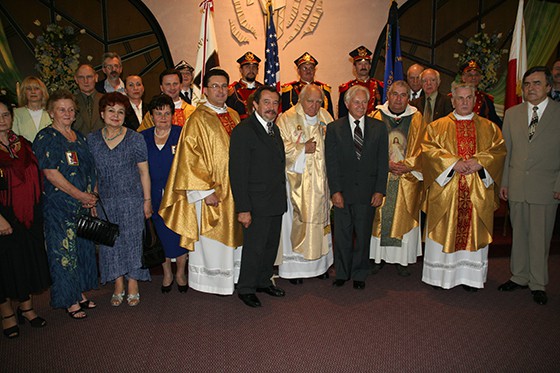
After Mass to celebrate the 65th Anniversary of the Katyn. Wojciech Seweryn with the late prelate Peszkowski and other priest celebrating Mass with representatives of Polonia and his wife Maria Seweryn.
Every morning he would call my mother: „Mrs. Maryla — a coffee, a coffee!” And my mother would make him that coffee because we must feed the hungry and give the thirsty drink. The man would help out with small chores around the house. My father would pay him, but he would just spend everything on cigarettes and alcohol. I didn’t like the fact, that they allowed him to use them in such a way. Finally, after 10 years, they contacted his family in Poland and sent him home. These actions would anger me often.
Today, after his death, many people come to me — many, who I don’t know — and say: „Your Father paid for my furniture when I came from Poland, because I had no money,” or „He helped me move,” or „He helped me find a job,” or „He came to me when I was in the hospital to feed me every day.” When I hear what they have to say, I ask myself, „How could these things have made me angry before?”
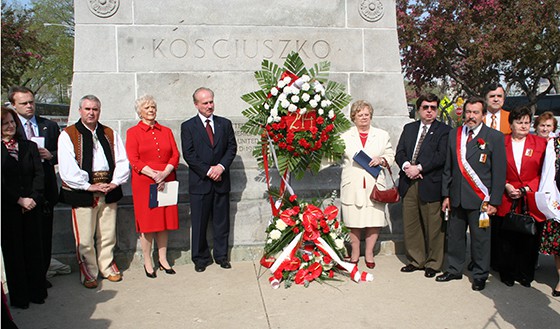
Late, Wojciech Seweryn as General Marshall of the May 3 Polish Constitution Day Parade with a group of representatives of Polonia organizations at the monument of Tadeusz Kosciuszko.
He helped raise my son until he was 7 years old. He would take him on the May 3rd parades, to Scout meetings, to Holy Mass in the intention of Poland. He would tell him many stories of Katyn. One day, my little Daniel told our priest that he will never travel to Poland because the Russians killed his great grandfather, and they will kill him, too. We had to explain to him that it’s not like that there today.
Together with late Lech Kaczynski the President of Poland and the late First lady of Poland, Maria Kaczynski at front of the Katyn Monument in the cemetery of St. Wojciech in Niles
He was like a father to my sister’s three daughters. He would call my granddaughter’s boyfriend and openly ask what the young man’s intentions toward his great granddaughter were. If they weren’t serious, he would tell the young man goodbye. He said he had the right, because he was more than just a grandfather. He knew everything about his family.

Seweryn explains to the President of Poland,the names on stones that are in front of the monument.
– I believe that my father carried the idea and need for the Katyn monument in his heart all his life. I remember how he would take me to the cemetery, to our little sister’s grave (my parents’ first child died young), on whose grave he chiseled a small statue of the Child Jesus. He would tell me of his plans to travel to Katyn one day, where his father was murdered, and bring some earth back to create a monument.
Late Wojciech Seweryn during the concert in honor of the visiting President of Poland Lech Kaczynski. Chicago 2007
It wasn’t possible to bring anything back from Katyn back then. The idea of a monument commemorating the massacre at Katyn was completely abstract. His first drawings were done in 1977. He even made models of the monument. In the beginning, he didn’t have any support. He was still waiting for his immigration papers, he was very busy helping us in Poland and arranging our emigration to the United States.
In 1993, Cardinal Glemp came to the United States and my father shared his dream with him. The Cardinal replied that he gives him and his idea his blessing. A year later, my father called to life the Committee for the Building of the Katyn Monument. When Cardinal Francis George was called as pastor of the Archdiocese of Chicago, Fr. Zdzislaw Peszkowski (the chaplain for the Families of Katyn and with whom my father was in constant contact), proposed to arrange an audience with the Cardinal concerning the monument. Bishop Jakubowski and Father Dzieszko and Father Osuch were also with him. Cardinal George knew of the Katyn massacre.
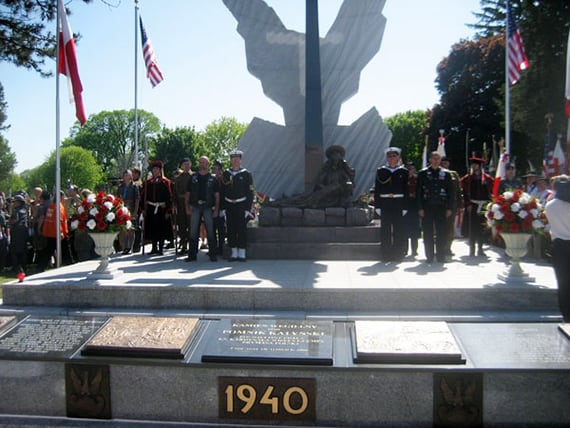
Sacrifice of the statue of Katyn by the Primate of Poland , Jozef Glemp. Niles 2009.
The result was that the Cardinal granted a place for the monument at the cemetery in Niles. How my father was thrilled! His dreams were finally coming true! He was 60 years old then.
– My father went to Katyn in 1995. It was a great experience for him. We were all concerned for him, but especially my father’s mother. It had great meaning to her that her son would be in the place that his father, her husband, was murdered years before. My father brought an urn with some soil from Katyn, which he placed in the family grave. My grandmother died a few months later.
In 2009 Józef Glemp, Primate of Poland decorates Wojciech Seweryn with the Primate Medal.
In the year 2000, my father received an invitation from the Polish Prime Minister, Jerzy Buzek, to come to the opening of the Polish War Cemetery in Katyn. He travelled there by train — as always.
– The Chicago sculptor Stefan Niedorezo, who finished the same art school as my father, told my father to believe in himself and to personally create the project for the monument. He was a great support for my father. Granite Gallery offered my father, for free, the place where he could work on the monument. It was a hall not too far from Interstate 90. He worked there for more than 3 months. He left the door open for air circulation, and many people would come to see what was going on with great interest. The Americans, who saw him working on the monument everyday, would often offer him something to eat and drink.
– On October 8th, 2000, Cardinal JOzef Glemp blessed the corner stone for the Katyn Monument in Niles. On May 17th, 2009, my father’s dream came true. The Primate of Poland personally blessed the Monument commemorating the Victims of the Katyn Massacre. This same Cardinal, who blessed my father and his idea 16 years earlier, believed then that his dream would come true.
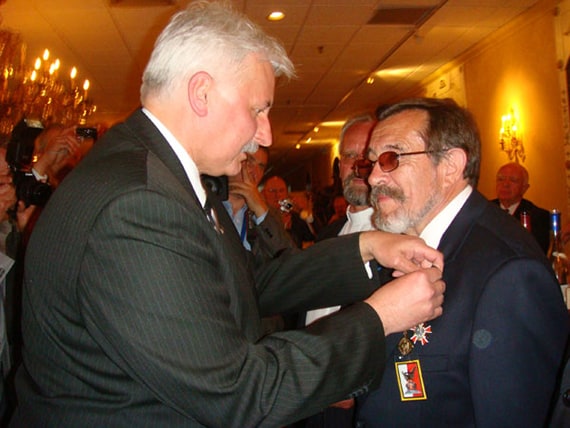
Wojciech Seweryn accepts Award from the President of Poland from the hands of Witold Waszczykowski.
2009, White Eagle, Niles
– In 2006, President Kaczynski came to Chicago. My father prepared a present for him: a model of the Katyn monument in Niles. He gave it to his beloved President (for my parents, President Kaczyski was very important —whatever he said was „holy”). It was a great honor for my father to receive the Commander’s Cross of the Order of Merit of the Republic of Poland from the hands of the President of Poland himself.
In 2009, he received yet another honor: the Officer’s Cross of the Order of Merit of the Republic of Poland from the hands of Witold Waszczykowski, who was the head of the National Security Bureau. On his trip to Katyn on April 10th, he took with him the proof of this medals of Honor. They came back to us — a little soiled, but whole. My father also had with him a briefcase filled with invitations to the celebrations of the 70th anniversary of the Katyn massacre that were to take place in Chicago on
April 25th, 2010, as well as diplomas of commendation for the people at the Polish House in Smolensk. This included a special commendation for Mrs. Stanislawa Afanasjewa who comes to the place of the catastrophe every day to light a votive candle and to pray.
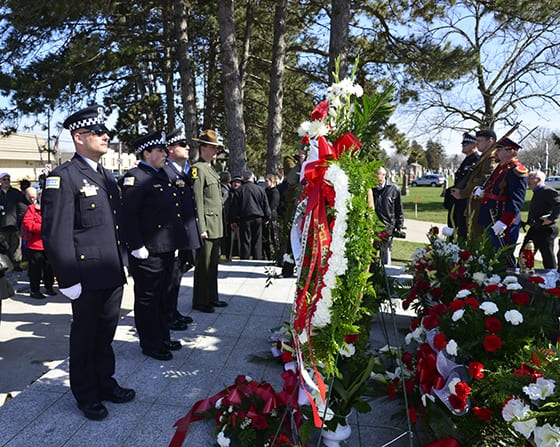
2012 – celebration of the 2nd anniversary of the Smlensk disaster
– A few days before his death, my father had the opportunity to plant an oak tree in our hometown of Zabno, and to pass to its residents the project for a monument. At his funeral, the mayor of Zabno said, „I believe that this is his will. I ask that this monument be erected in the occasion of the 75n anniversary of the Katyn Massacre and the 5th anniversary of the catastrophe of Smolensk.”
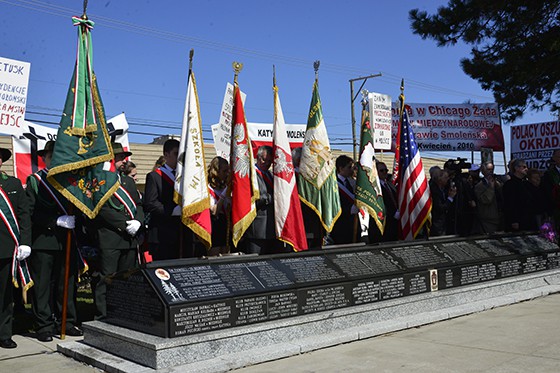
Honoring Smolensk’s catastrophe victims in front of the Katyn monument. Niles 2012
– I always believed that my father would do everything for us. But I have to say that sometimes we were even jealous because we thought the Katyn matter was more important to him than we were. I would tell him, „Live among us — be among the living!” But he would always have Katyn on his mind. Now I believe that that was his purpose: to carry Katyn throughout his entire life…
The interview was conducted by Ewa Uszpolewicz.
Source : Special edition to commemorate the I st anniversary of the Smoleńsk catastrophe.
Chicago April 2-nd -10th in 2011
Photo: Krystyna Teller and Andrew Brach


